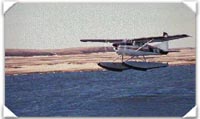Genetics
 The
Molecular Ecology Laboratory at the Alaska Science Center - Biological
Science Office (ASC-BSO) uses mitochondrial and nuclear microsatellite DNA markers in a
variety of fish, bird, mammal, and plant species. These markers are
valuable tools for a better understanding of breeding and wintering
population subdivision, individual behavior, gene flow, species
systematics, and evolution. The
Molecular Ecology Laboratory at the Alaska Science Center - Biological
Science Office (ASC-BSO) uses mitochondrial and nuclear microsatellite DNA markers in a
variety of fish, bird, mammal, and plant species. These markers are
valuable tools for a better understanding of breeding and wintering
population subdivision, individual behavior, gene flow, species
systematics, and evolution.
The Molecular
Ecology Laboratory has developed a series of avian microsatellite,
mitochondrial and numt-specific DNA markers, as well as protocols for
non-invasive sampling of wild bird populations. Studies currently underway
include population analyses of ducks, geese, shorebirds, seabirds and
passerines.
Current mammal projects involve
characterizing genetic variation of wolf (Canis lupus), polar and
brown bear (Ursus arctos and U. maritimus), Pacific walrus (Odobenus
rosmarus), and sea otter (Enhydra lutris) populations in Alaska,
Canada, and Russia. These population level data subsequently for the basis
for more specific questions regarding evolutionary relationships among
bear species, levels of inbreeding within wolf populations, genetic
consequences of translocation efforts, and the sex of sea otter harvested
for subsistence. The laboratory is also developing protocols for
non-invasive sampling of brown bears to aid in populations surveys.
The Laboratory is currently
developing and using genetic techniques for characterization of wild fish
populations during various stages of their life cycles. Microsatellite
markers have been developed by the lab for use in questions regarding
chinook, sockeye, chum, steelhead/rainbow trout and coho salmon. Other
microsatellite markers, as well as growth hormone, and restriction
fragment length polymorphism techniques are also being used. Genetic
research supports fisheries projects characterizing the genetic makeup of
fish populations within established and newly created glacial drainages
and lake basins. Genetic analysis of coho salmon populations in the
Glacier bay area of Southeast Alaska is being conducted to help understand
1) the degree of population differentiation 2) the process by which new
populations are founded, and 3) the smallest viable population size.
Glacier Bay provides an ideal experimental location because the rapid
recession of the glaciers has exposed relatively new habitats for
colonization. By comparing the genetic profiles of coho populations among
streams of varying ages, more can be learned about the processes of
colonization and what the minimum effective population size is.
|
 This
project deals with development and assessment of techniques for sampling
wildlife and habitats, designing ecological experiments, estimating
biological and ecological parameters, testing biological and ecological
hypotheses, and modeling population, community and ecosystem dynamics.
This
project deals with development and assessment of techniques for sampling
wildlife and habitats, designing ecological experiments, estimating
biological and ecological parameters, testing biological and ecological
hypotheses, and modeling population, community and ecosystem dynamics. The
Wildlife Veterinarian provides surgical and medical services and advice to
biologists, especially in the area of drug immobilization of animals and
implantation of transmitters. In addition, he conducts research, serves as
Controlled Substances Officer for the Center, and serves on the
Institutional Animal Care and Use Committee.
The
Wildlife Veterinarian provides surgical and medical services and advice to
biologists, especially in the area of drug immobilization of animals and
implantation of transmitters. In addition, he conducts research, serves as
Controlled Substances Officer for the Center, and serves on the
Institutional Animal Care and Use Committee. The
Molecular Ecology Laboratory at the Alaska Science Center - Biological
Science Office (ASC-BSO) uses mitochondrial and nuclear microsatellite DNA markers in a
variety of fish, bird, mammal, and plant species. These markers are
valuable tools for a better understanding of breeding and wintering
population subdivision, individual behavior, gene flow, species
systematics, and evolution.
The
Molecular Ecology Laboratory at the Alaska Science Center - Biological
Science Office (ASC-BSO) uses mitochondrial and nuclear microsatellite DNA markers in a
variety of fish, bird, mammal, and plant species. These markers are
valuable tools for a better understanding of breeding and wintering
population subdivision, individual behavior, gene flow, species
systematics, and evolution.
 The
banking of environmental specimens under cryogenic conditions for future
retrospective analysis has been recognized for many years as an important
part of environmental monitoring programs. Since 1987, the Alaska Marine
Mammal Tissue Archival Project (AMMTAP) has been collecting tissue samples
from marine mammals for archival in the National Biomonitoring Specimen
Bank (NBSB) at the National Institute of Standards and Technology (NIST)
in Gaithersburg, Maryland, USA.The project is a joint effort by the U.S.
Geological Survey Biological Resources Division (USGS\BRD)
The
banking of environmental specimens under cryogenic conditions for future
retrospective analysis has been recognized for many years as an important
part of environmental monitoring programs. Since 1987, the Alaska Marine
Mammal Tissue Archival Project (AMMTAP) has been collecting tissue samples
from marine mammals for archival in the National Biomonitoring Specimen
Bank (NBSB) at the National Institute of Standards and Technology (NIST)
in Gaithersburg, Maryland, USA.The project is a joint effort by the U.S.
Geological Survey Biological Resources Division (USGS\BRD)  Based
on aerial surveys on wintering grounds, populations of Pacific black brant
(Branta bernicla nigricans) have fluctuated around the minimum
population level, while numbers in nesting colonies on the Yukon-Kuskokwim
Delta (YKD) have declined severely during the 1980s. To meet population
recovery goals it is important to monitor the reproductive status of these
colonies. Annual surveys by ground crews are impractical because of the
large areas involved and ocular surveys from aircraft are not possible
because of high densities of nests. Photography has been widely used to
estimate numbers of other species of waterfowl, but is impractical because
of the large areas, poor weather conditions, and cryptic coloration of
brant. However, high-quality video imagery can minimize or overcome these
problems. This study assesses various photographic techniques and
analytical methods for enumerating brant and evaluating habitat
conditions. This technique also has application in assessing changes in
land cover.
Based
on aerial surveys on wintering grounds, populations of Pacific black brant
(Branta bernicla nigricans) have fluctuated around the minimum
population level, while numbers in nesting colonies on the Yukon-Kuskokwim
Delta (YKD) have declined severely during the 1980s. To meet population
recovery goals it is important to monitor the reproductive status of these
colonies. Annual surveys by ground crews are impractical because of the
large areas involved and ocular surveys from aircraft are not possible
because of high densities of nests. Photography has been widely used to
estimate numbers of other species of waterfowl, but is impractical because
of the large areas, poor weather conditions, and cryptic coloration of
brant. However, high-quality video imagery can minimize or overcome these
problems. This study assesses various photographic techniques and
analytical methods for enumerating brant and evaluating habitat
conditions. This technique also has application in assessing changes in
land cover.